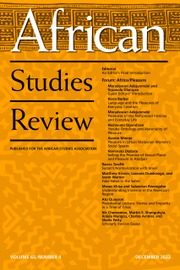Adom Getachew’s Worldmaking After Empire: The Rise and Fall of Self-Determination is a seminal work that contributes to the field of postcolonial studies and opens new vistas in political theory. Getachew approaches this study with a historical method that draws on the work of several key figures whose intellectual contributions helped to frame twentieth-century debates surrounding the aspirations, strategies, limits, and disillusionment of anticolonial movements. Getachew’s method also draws on international legal studies and international political economy to provide a very rich and textured account of the subject.
Getachew’s account of “the rise and fall of self-determination” opens “at midnight on March 6, 1957” as Prime Minister Kwame Nkrumah announces the independence of the former British colony of the Gold Coast, now to be known as Ghana. Getachew notes Nkrumah’s remarks on that occasion placed the “revolutionary implications” of Ghanaian independence in the larger global context of postcolonial independence with a specific focus on the importance of African unity. Nkrumah remains one of the key figures throughout as Getachew charts his theory and practice as a Pan-Africanist leader, advocate for African federation, and then critic of neocolonialism. Other key figures covered are Nnamdi Azikiwe, W.E.B. Du Bois, Michael Manley, Julius Nyerere, George Padmore, and Eric Williams (listed on p. 2). As this list indicates, the focus is on Anglophone anticolonial leadership in Africa and the Caribbean. If there is a criticism to be made of this work, it lies in this focus on the elite level of leadership discourses. Some attention to the broader movements that provided an underlaying base of support for these figures—such as Nkrumah’s Convention People’s Party or in a later chapter Michael Manley’s People’s National Party—might have provided additional depth and context to Getachew’s already rich descriptions of the political and ideological dynamics at work throughout the periods covered. One case where such a broader lens with more attention to the social-historical context could have been Getachew’s discussion of the role of Eric Williams’s leadership in Trinidad and Tobago. Williams is rightly described as sharing “the perspective of federalists like … Nkrumah” who supported “regional integration and redistribution” (169). Entirely true, when looked at from a global point of view, Eric Williams was a visionary and radical leader who, like his African counterparts Nkrumah and Nyerere, understood that the nation-state he led needed to find strength in cohesion and concrete solidarity, through robust federation (which Williams consistently described as the key to the rise of the United States after its independence from the British Empire; 110ff). Looked at from below, however, and within his national context, Williams might be seen as a surprisingly conservative figure. Contrasted with a figure like labor leader George Weekes (who is not mentioned by Getachew but is the subject of a recent good study by Godfrey Vincent of Wilberforce College) or other trade unionist and/or populist leaders in the postcolonial contexts Getachew focuses upon could have provided even more nuanced understandings of the dimensions in which leaders like Williams were hemmed in from both below and above, as well as open understanding of paths not taken.
One of the best chapters of this book is the second chapter on “the Counterrevolutionary Moment,” which provides an account of how the League of Nations, ostensibly founded on the Wilsonian principle of self-determination, worked to preserve colonialism while placing the few independent Caribbean and African states in second-class status. The counterpoints that Getachew draws out so well in this chapter include the contrast between Lenin’s critique of imperialism and position on national self-determination and the Wilsonian internationalist project that effectively helped make the world safe for the continuation of imperialism. The most intriguing counterpoint of all here is Getachew’s discussion of the role Jan Smuts played in this period as an ostensible advocate for national self-determination in a racist framework that rendered black self-determination effectively impossible in practice. As such, we are left with a better understanding of the global diplomatic context from which the post-World War II apartheid state would emerge in South Africa. Turning then to anticolonial independence movements in the subsequent chapters, the reader now has an even better appreciation of the intellectual challenges and struggles that DuBois, Williams, and others were facing in the 1930s and 40s as they fought for true national self-determination.
From independence through failed projects of federation and then the disappointing pursuit of a New International Economic Order (NIEO) in the 1960s and 70s, Getachew continues to develop the narrative of the book through her focus on leading figures (Manley) and their counterpoints (Daniel Patrick Moynihan, as critic of NIEO in this case). The method is focused, engaging, and illuminating but again stimulates an interest in pursuing the story even more broadly. In this case, for instance, a look at Henry Kissinger’s role in undermining practical NIEO proposals to adjust inequitable terms of trade might have put the response of the United States in a different (and even less favorable) light than by focusing on the relatively liberal (and, I would argue, less powerful) Moynihan. That said, this work is beyond doubt a major scholarly achievement and a vital contribution to our understanding of how to frame a truly global and historically adequate approach to political theory; it is a book from which many readers can and must learn so much that is of ongoing importance in the twenty-first-century world.

